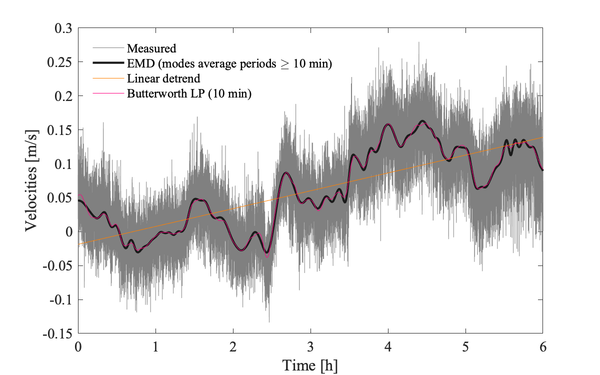Decomposing velocity measurements
{{#default_form:Processing}}
{{#arraymap:
Velocity point-measurements
|,|x||}}
{{#arraymap:level 2 segmented and quality controlled|,|x||}}
The quality-controlled velocities are first detrended before being further analysed to determine mean flow past the sensor and surface wave statistics. These quantities are necessary for later choosing the appropriate inertial subrange model for spectral fitting.
Methods for detrending
There is no exact definition for what consists of a "trend", nor any set algorithm for identifying the trend. The following techniques can be used for detrending [1]:
- Linear trend removal
- Low-pass linear filters (e.g., butterworth filter)
- Empirical modal decomposition
The first two methods presume the original time series is stationary and linear, while the third is adaptive and applicable to nonlinear and non-stationary timeseries.

Long continuous sampling
Info needs simplifying after convening as a subgroup Different techniques dependent on whether measurements were collected continuously or in long bursts (define here).
Short burst sampling
A short burst is typically at most 2-3x the expected largest turbulence length scales. As a rule of thumb, turbulence estimates from the inertial subrange of velocity rely on 5 to 15 min long-segments. ``` Act of segmenting is effectively a form of filtering
- Linear trend removal
- Empirical mode decomposition (nonlinear and/or non-stationary signal)
Determining the mean flow
Notes
- ↑ 1.0 1.1 {{#arraymap:Zhaohua Wu, Norden E. Huang, Steven R. Long, and Chung-Kang Peng|,|x|x|, |and}}. 2007. On the trend, detrending, and variability of nonlinear and nonstationary time series. PNAS. doi:10.1073/pnas.0701020104
